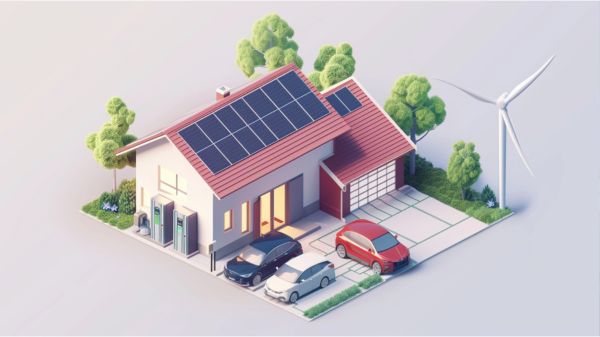Imagine your home as a vibrant garden, each solar panel a blooming flower capturing the sun’s energy. In just 11 simple steps, you can reduce your carbon footprint and harness the power of home solar.
Assess your energy consumption, evaluate solar potential, and select the right panels. Determine optimal placement, install the system, and reduce energy waste. Switch to LED lighting, implement smart energy management, and educate others. Together, let’s cultivate a greener future.

Assess Energy Consumption
First, take a detailed inventory of your energy consumption to identify areas where you can make changes. Assessing your energy consumption is an essential step towards adopting an energy-saving and sustainable lifestyle. Start by examining your monthly energy bills and noting the energy usage for each appliance and electronic device. Look for patterns and identify which areas consume the most energy.
Consider investing in a smart energy monitor to track real-time energy usage and gain deeper insights. Additionally, conduct a home energy audit to identify any areas of energy wastage, such as drafts, inefficient insulation, or outdated appliances. Armed with this data, you can prioritize the implementation of energy-saving tips and make informed decisions to reduce your carbon footprint.
Evaluate Solar Potential
To evaluate your solar potential, begin by assessing the orientation and shading of your roof.
The orientation of your roof plays a crucial role in determining how much sunlight it receives throughout the day. Ideally, a south-facing roof gets the most sunlight, but east and west-facing roofs can also be viable options.
Next, consider the shading on your roof. Trees, nearby buildings, or other obstructions can block sunlight and reduce the efficiency of your solar panels.
Analyzing the solar feasibility involves using tools like solar pathfinders or online solar calculators to determine the solar potential of your location. These tools take into account factors like your geographical location, roof tilt, and azimuth, and can provide a detailed analysis of your solar potential.
Select the Right Solar Panels
When selecting the right solar panels for your home, there are several important factors to consider.
First, panel efficiency and output are crucial in determining how much energy your system will produce. Look for panels with higher efficiency ratings and power outputs to maximize your electricity generation.
Second, consider the cost and installation process. Compare prices from different manufacturers and evaluate the ease of installation to find the best option for your budget and needs.
Lastly, think about the longevity and maintenance requirements of the panels. Choose panels that are durable and require minimal maintenance to ensure a long lifespan and optimal performance.
Panel Efficiency and Output
To select the right solar panels for your home, it’s important to consider panel efficiency and output. Here are a few key factors to keep in mind when evaluating solar panel options:
- Panel Efficiency: Look for panels with high efficiency ratings, as this indicates how effectively they convert sunlight into electricity. Higher efficiency panels can generate more power in the same amount of space, making them a wise choice for homeowners with limited roof space.
- Output: Consider the power output of the panels, which is typically measured in watts. Higher wattage panels will generate more electricity, allowing you to maximize your energy production and potentially offset a larger portion of your energy consumption.
- Panel Durability: Assess the durability of the panels, as they’ll be subjected to various weather conditions over their lifespan. Look for panels with robust construction and warranties that guarantee performance over a long period of time.
- Solar Panel Technology: Stay informed about the latest advancements in solar panel technology. Newer technologies, such as monocrystalline or polycrystalline panels, may offer higher efficiency and improved performance.
Cost and Installation Process
Consider the cost and installation process of selecting the right solar panels for your home.
When it comes to installing solar panels, it’s important to conduct a cost analysis to determine the financial feasibility of the project. The cost of solar panels can vary depending on factors such as panel efficiency, size, and brand. Additionally, installation costs should be taken into account, as they can significantly impact the overall expenses.
It’s advisable to obtain multiple quotes from different solar panel installers to compare prices and choose the most cost-effective option. The project timeline is another crucial factor to consider. From obtaining permits to completing the installation, the timeline can vary depending on the complexity of the project and the availability of the installer.
Longevity and Maintenance
To ensure the longevity and proper maintenance of your solar panels, it’s essential to carefully select the right panels for your home. Here are some factors to consider:
- Long term durability: Look for solar panels that are made with high-quality materials and have a long warranty period. This ensures that the panels will last for many years and withstand different weather conditions.
- Efficiency: Choose solar panels that have a high conversion efficiency. This means that they can convert more sunlight into electricity, maximizing the energy output of your system.
- Maintenance tips: Regularly clean your solar panels to remove dirt, dust, and debris that can reduce their efficiency. Also, inspect the panels for any signs of damage or wear and tear. If you notice any issues, contact a professional for repairs or replacements.
- Monitoring system: Install a monitoring system that allows you to track the performance of your solar panels. This helps you identify any problems early on and take necessary actions to ensure optimal performance.
Determine Optimal Placement
Where should you ideally place your solar panels for optimal energy production and efficiency?
The optimal location for solar panel placement is determined by several factors that can significantly impact their performance. Firstly, the angle at which the panels are installed plays a crucial role. In general, panels should be placed facing south to maximize sun exposure throughout the day. Additionally, the tilt of the panels should correspond to the latitude of your location. For example, if you live at a latitude of 35 degrees, the panels should be tilted at a 35-degree angle.
Furthermore, shading should be minimized as much as possible, as even a small amount of shade can significantly reduce energy production. Lastly, the overall design and layout of your property should be considered to ensure that there are no obstructions that may cast shadows on the panels.

Install Solar Power System
Once you have determined the optimal placement for your solar panels, it’s time to install your solar power system. Installing a solar power system offers numerous benefits, not only for your wallet but also for the environment.
Here are some key reasons why you should consider installing a solar power system:
- Renewable energy: Solar power is a clean and renewable energy source that reduces your reliance on fossil fuels and minimizes the release of greenhouse gases.
- Cost savings: By generating your own electricity, you can significantly reduce your monthly energy bills and potentially earn money by selling excess energy back to the grid.
- Long-term investment: Solar panels have a lifespan of 25-30 years, making them a long-term investment that can provide consistent energy savings over time.
- Environmental impact: By using solar power, you can reduce your carbon footprint and contribute to a cleaner and healthier planet.
Installing a solar power system is a practical and sustainable way to harness the benefits of renewable energy sources while making a positive impact on the environment.
Monitor Energy Production
After installing your solar power system, it’s important to monitor your energy production to ensure optimal efficiency and maximize your cost savings. Monitoring your energy usage allows you to track solar performance and identify any issues that may arise. By keeping a close eye on your system’s production, you can quickly identify any potential problems and address them promptly.
Tracking solar performance also enables you to determine if your system is generating the expected amount of energy, helping you make informed decisions about your energy usage. Additionally, monitoring your energy production allows you to identify patterns in your energy usage and make adjustments to further reduce your carbon footprint.
Maximize Energy Efficiency
Are you wondering how to maximize the energy efficiency of your home solar power system? Here are some key steps to help you make the most of your solar potential and reduce your carbon footprint:
- Conduct an energy audit to identify areas where energy is being wasted.
- Upgrade to energy-efficient appliances and lighting.
- Improve insulation and seal any air leaks in your home.
- Install a smart thermostat to optimize energy usage.
By implementing these energy-saving home improvements, you can significantly reduce your overall energy consumption and maximize the effectiveness of your solar power system.
An energy audit will help you identify specific areas for improvement, while upgrading to energy-efficient appliances and lighting will reduce the amount of energy needed. Improving insulation and sealing air leaks will minimize heat loss, allowing your home to stay cooler in the summer and warmer in the winter. Lastly, a smart thermostat will help you optimize your energy usage by adjusting temperatures based on your preferences and occupancy.
With these steps, you can maximize your solar potential and make your home more energy-efficient.
Reduce Energy Waste
To reduce energy waste and further optimize your home solar power system, prioritize the efficient use of electricity in your daily activities. Implementing energy-saving habits can significantly reduce your carbon footprint and increase the efficiency of your solar power system.
Start by turning off lights and electronic devices when not in use, and use energy-efficient appliances and light bulbs. Additionally, make a conscious effort to reduce phantom energy usage by unplugging devices that aren’t being used.
Another effective way to reduce energy waste is by adopting sustainable transportation methods. Consider carpooling, biking, or using public transportation whenever possible. These alternatives not only help reduce greenhouse gas emissions but also save you money on fuel costs.
Switch to LED Lighting
Switching to LED lighting is a cost-effective and energy-efficient way to reduce your carbon footprint with home solar power. LED lighting offers numerous benefits, making it an excellent choice for environmentally conscious homeowners:
- Energy Efficiency: LED lights use up to 75% less energy than traditional incandescent bulbs, resulting in significant energy savings.
- Long Lifespan: LED lights can last up to 25 times longer than incandescent bulbs, reducing the need for frequent replacements.
- Reduced Heat Emission: LED lights emit very little heat compared to incandescent bulbs, making them safer and more energy-efficient.
- Lower Maintenance Costs: Due to their long lifespan, LED lights require less frequent replacement, resulting in lower maintenance costs over time.
While the upfront cost of LED lighting may be slightly higher than traditional bulbs, the long-term savings in energy consumption and maintenance costs make it a worthwhile investment. By making the switch, you can save money and reduce your carbon footprint simultaneously.
Implement Smart Energy Management
To further reduce your carbon footprint with home solar power, implementing smart energy management is crucial.
One way to do this is by using efficient appliances that consume less electricity. Look for appliances with high energy ratings, such as Energy Star certified products.
Additionally, consider switching to energy-saving lighting options like compact fluorescent lamps (CFLs) or light-emitting diodes (LEDs), which use significantly less energy than traditional incandescent bulbs.
Efficient Appliance Usage
By using smart energy management, you can effectively reduce your carbon footprint by optimizing the usage of your appliances. Here are some energy-saving tips to make your appliances more efficient:
- Choose energy-efficient appliances: Look for appliances that have the Energy Star label, as they’re designed to consume less energy.
- Unplug unused appliances: Even when turned off, many appliances continue to draw power. Unplugging them when not in use can save energy.
- Use power strips: Plug multiple appliances into a power strip and turn it off when not in use. This prevents them from using standby power.
- Adjust temperature settings: Lowering the temperature on your refrigerator and water heater can help save energy.
Energy-Saving Lighting Options
Maximize your energy efficiency with these 5 simple lighting options.
By choosing energy-saving bulbs and eco-friendly lighting options, you can significantly reduce your carbon footprint and save money on electricity bills.
LED bulbs are a popular choice for their energy efficiency and long lifespan. They use up to 75% less energy than traditional incandescent bulbs and can last up to 25 times longer.
Another option is compact fluorescent bulbs (CFLs), which are up to 80% more efficient than incandescent bulbs. They also have a longer lifespan.
Additionally, consider installing smart lighting systems that allow you to control and monitor your lights remotely. These systems can automatically adjust lighting levels based on occupancy and natural light, further reducing energy consumption.
Implementing these lighting options is a simple yet effective way to make your home more energy-efficient and environmentally friendly.

Educate and Inspire Others
Help spread awareness and motivation by sharing your home solar power journey with others. By educating and inspiring those around you, you can inspire change and promote sustainability. Here are some ways you can do so:
- Host a solar power workshop or presentation in your community to share your knowledge and experiences.
- Utilize social media platforms to showcase the benefits of home solar power and provide tips for installation and maintenance.
- Write a blog or contribute articles to local newspapers and magazines to reach a wider audience.
- Participate in local events, such as sustainability fairs or green living expos, to engage with like-minded individuals and share your story.
Conclusion
Congratulations! You’ve taken the first step towards reducing your carbon footprint and making a positive impact on the environment by embracing home solar power.
By following these 11 simple steps, you can assess your energy consumption, evaluate solar potential, select the right panels, determine optimal placement, and install a solar power system.
Additionally, reducing energy waste, switching to LED lighting, implementing smart energy management, and educating others will further enhance your sustainability efforts.
Remember, every little bit helps, and together we can be the change we want to see in the world. So go ahead, shine bright like the sun and lead the way towards a greener future!




